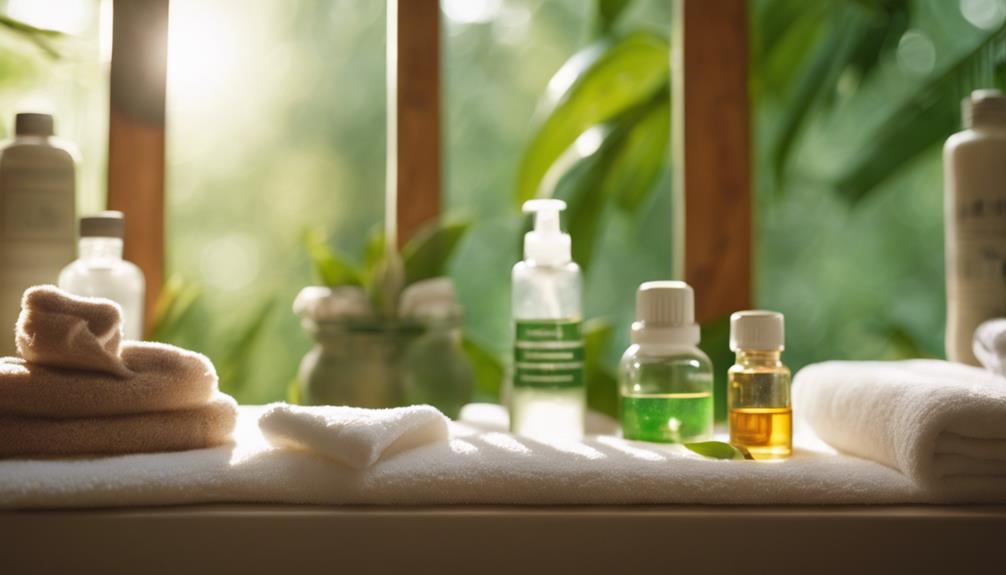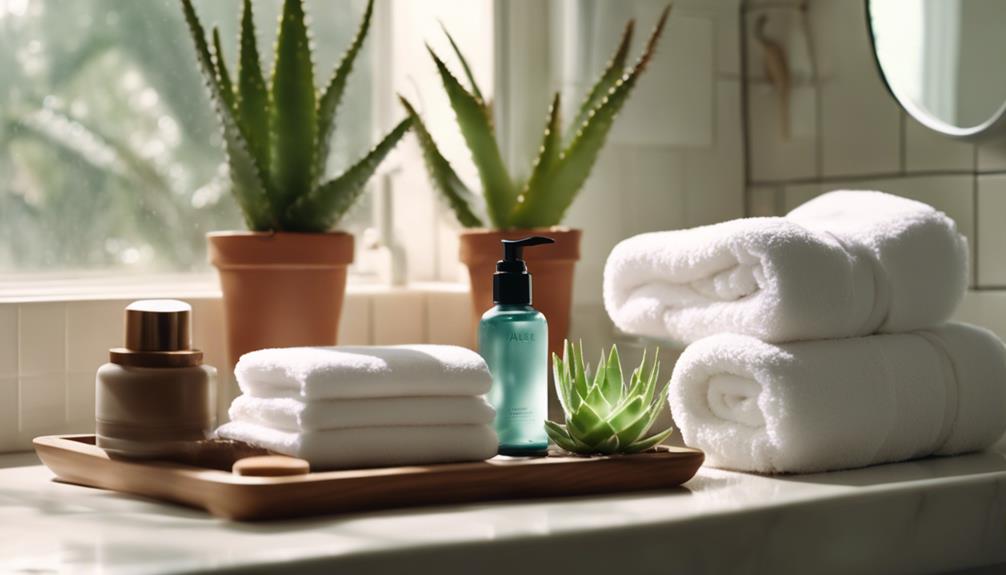To ensure tanning beds are sanitized in an environmentally friendly way, you can begin by utilizing natural cleaners such as vinegar and water solution or a baking soda paste. Enhance the antimicrobial properties by incorporating essential oils. Make it a habit to clean surfaces daily using microfiber cloths and conduct a deep cleaning on a weekly basis. It is important to remember to sanitize the bulbs every two weeks with diluted hydrogen peroxide for thorough hygiene. Opt for eco-friendly commercial cleaners, such as citrus-based or plant-based options, to reduce your environmental footprint. Prioritize recyclable packaging and provide training to staff on sustainable practices. For further tips on maintaining an eco-friendly tanning environment, continue exploring additional suggestions and techniques.
Key Takeaways
- Utilize a vinegar and water solution for effective sanitization, enhanced with essential oils for added antimicrobial benefits.
- Implement a daily cleaning routine focusing on high-touch areas and perform deep cleaning weekly with natural cleaners.
- Opt for eco-friendly commercial cleaners like tea tree oil and citrus-based products to minimize chemical exposure.
- Choose washable microfiber cloths for cleaning instead of disposable wipes to reduce waste and promote sustainability.
Natural Cleaning Solutions
When you want to keep your tanning bed spotless and safe, natural cleaning solutions like vinegar and baking soda are effective and eco-friendly options.
Mix equal parts white vinegar and water to create a powerful cleaner that sanitizes the acrylic surfaces, leaving a fresh scent. You can enhance this solution with essential oils like tea tree or lemon for added antimicrobial properties.
For a deeper clean, combine baking soda with warm water to form a paste. Apply it to the surface, let it sit, and then wipe away to remove dead skin cells and grime.
Hydrogen peroxide diluted with water also works well, targeting germs when sprayed and wiped down, ensuring your tanning bed remains hygienic and ready for use.
Eco-Friendly Commercial Cleaners

Eco-friendly commercial cleaners, designed with natural ingredients, effectively kill germs while being gentle on your skin and the environment. These products not only promote a healthier tanning experience but also come in recyclable packaging, supporting sustainability.
Here are some options you can consider:
- Tea Tree Oil Cleaner: Known for its antibacterial properties, it's a great natural disinfectant.
- Citrus-Based Cleaners: These products harness the power of citrus oils to cut through grime and eliminate odors.
- Plant-Based Surface Cleaners: Look for formulations made from plant extracts that provide strong cleaning without harsh chemicals.
- Eco-Friendly Wipes: Convenient and biodegradable, these wipes make sanitizing quick and easy.
Using these eco-friendly options guarantees a safe and sustainable tanning environment!
Effective Cleaning Techniques

Utilizing eco-friendly commercial cleaners sets the stage for effective cleaning techniques that guarantee tanning beds remain hygienic and safe for use. Start by regularly wiping surfaces with microfiber cloths to prevent scratches and limit chemical exposure. Establish a daily cleaning routine, focusing on high-touch areas like handles and knobs. For deeper cleans, unplug the tanning bed and use gentle, natural cleaners. Don't forget to sanitize bulbs thoroughly.
| Cleaning Technique | Frequency | Recommended Cleaner |
|---|---|---|
| Surface Wiping | Daily | Eco-friendly commercial cleaner |
| Deep Cleaning | Weekly | Vinegar-based solution |
| Bulb Sanitization | Bi-weekly | Hydrogen peroxide mixture |
| Handle Disinfection | Daily | Lemon juice solution |
| Grime Removal | Monthly | Baking soda paste |
Proper Eye Protection

To guarantee your eyes are well-protected during tanning sessions, choose goggles specifically designed for UV protection that fit snugly to prevent any light leakage. Proper eye protection is essential for a safe tanning experience.
Here are some tips to make certain you're safeguarding your vision:
- Select UV-rated goggles: Always pick goggles specifically made for tanning beds.
- Check for a snug fit: Make sure they fit comfortably and securely on your face.
- Look for anti-fog features: This keeps your vision clear during the session.
- Replace them regularly: Update your goggles to maintain hygiene and effectiveness.
Skin Preparation Guidelines

Preparing your skin properly before a tanning session can greatly improve your results and guarantee a more even tan.
Start by exfoliating your skin 24 hours in advance to remove dead skin cells, which allows for better absorption of the tanning solution.
Hydration is key, so apply a moisturizer after exfoliating to keep your skin supple.
When it's time for your tanning session, skip heavy makeup and lotions, as they can create barriers that affect how the tan develops.
Always conduct patch tests for any new products to avoid potential reactions.
Sustainable Sanitization Practices

Proper skin care sets the stage for a successful tanning experience, and it's equally important to adopt sustainable sanitization practices to maintain a clean and eco-friendly tanning environment.
Here are some effective ways to guarantee your tanning space stays hygienic while being kind to the planet:
- Use Natural Cleaners: Opt for vinegar, lemon juice, or baking soda mixed with water for a safe cleaning solution.
- Implement UV-C Light: Invest in UV-C sanitization devices to kill germs without harsh chemicals.
- Reusable Materials: Choose washable microfiber cloths instead of disposable wipes to minimize waste.
- Staff Training: Educate your team on sustainable cleaning practices to foster a greener atmosphere.
Monitoring Environmental Impact

Regularly evaluating the environmental impact of your cleaning products and practices guarantees a sustainable approach to tanning bed sanitation.
Start by reviewing the ingredients in your cleaners; opt for natural or eco-friendly alternatives to minimize harm.
Keep track of your usage and waste generated from cleaning supplies—look for ways to reduce or reuse.
Implement a feedback system with staff to discuss the effectiveness and environmental implications of current products.
Consider the packaging as well; choose items with recyclable materials.
Finally, stay informed about new eco-friendly products and practices that emerge in the market.
Consistently monitoring these factors helps you maintain a commitment to sustainability while ensuring a hygienic tanning environment for your clients.
Frequently Asked Questions
How Often Should I Clean a Tanning Bed?
You should clean a tanning bed after every use to maintain hygiene. Daily cleaning helps prevent the buildup of germs, ensuring a safe and pleasant experience for every customer who uses the bed.
Can I Use Bleach on Tanning Beds?
You shouldn't use bleach on tanning beds. It can damage the acrylic surfaces and create harmful fumes. Instead, opt for natural cleaners like vinegar or baking soda to guarantee safe, effective sanitation without compromising the equipment.
What Are the Benefits of Using Eco-Friendly Cleaners?
Did you know that nearly 70% of commercial cleaners contain harmful chemicals? Using eco-friendly cleaners not only protects your health but also reduces environmental impact, ensuring a safer space for you and future generations.
Are There Specific Brands of Eco-Friendly Sanitizers Recommended?
You'll find several brands like Seventh Generation and Method that offer eco-friendly sanitizers. These products effectively kill germs while using natural ingredients, making them safe for you and the environment. Look for recyclable packaging too!
How Do I Store Homemade Cleaning Solutions Safely?
Imagine mixing a vinegar solution for cleaning. To store it safely, use a labeled glass container away from sunlight, ensuring it's out of reach of children. Always keep it tightly sealed to prevent spills.
Are Tanning Beds Harmful to the Environment and What Can I Do to Minimize Their Impact?
Using ecofriendly tanning bed care can minimize the negative impact of tanning beds on the environment. Tanning beds contribute to energy consumption and chemical waste. To minimize their impact, consider using ecofriendly cleaning products, turn off the bed when not in use, and properly dispose of tanning bed materials.
Conclusion
By embracing these eco-friendly tips for tanning bed sanitation, you're not just ensuring a clean space for yourself—you're also making a positive impact on the planet. Consider using natural cleaning products and biodegradable wipes to sanitize the tanning bed surfaces, reducing the use of harsh chemicals that can harm the environment. Additionally, regularly cleaning the bed and its accessories with ecofriendly tanning bed care tips like using a vinegar and water solution can help minimize the environmental impact of your tanning routine. By being mindful of the products and methods you use for tanning bed sanitation, you can contribute to a healthier planet while maintaining a hygienic tanning experience. Consider investing in a reusable and washable tanning bed cover to reduce the use of disposable options that end up in landfills. In addition, consider scheduling regular maintenance and deep cleaning of the tanning bed with ecofriendly tanning bed care products to ensure its longevity and reduce the need for replacement, further minimizing its environmental impact. By incorporating these ecofriendly tanning bed care practices into your routine, you can enjoy a clean and sustainable tanning experience while making a positive contribution to the environment. Consider also adopting energy-efficient practices in your tanning salon, such as using LED lighting and adjusting the thermostat to conserve electricity. Implementing these ecofriendly tanning bed care tips can not only reduce your environmental footprint but also save you money on utility bills in the long run. Finally, educating clients about the importance of ecofriendly tanning bed care and offering them the option to participate in sustainable practices can help spread awareness and encourage others to make environmentally conscious choices. Incorporating these ecofriendly tanning bed care tips into your salon’s operations can lead to a cleaner, greener, and more sustainable tanning experience for everyone.
It's a beautiful coincidence that caring for your skin can align with caring for the Earth. Each time you step into that bed, you're creating a rejuvenating experience that reflects your values.
So, let's keep our tanning sessions sustainable and enjoy the sun-kissed glow, knowing we're doing our part for a greener future.







